Description of levels
The
fictive
development
and
calculation
of
your
lithium-ion
cell
begins
with
the
selection
of
the
cell
type.
You
can
choose
between
3
different
cell
types.
By
clicking
on
the
respective
button
of
the
desired
cell
type
you
get
to
the
main
level
of
the
app.
The prismatic cell has a solid metal case with both contacts in the lid.
To
simplify
the
calculation
of
the
cell
parameters,
it
is
assumed
that
the
electrodes
and
the
separator
are
stacked.
Wound
electrodes
are
not
considered.
The
pouch
cell
does
not
have
a
fixed
housing,
the
electrode
stack
is
sealed
in
special
foil.
There
are
2
different
ways
of
leading
the
tabs
out
of
the
foil.
You
can
choose
between
opposite
or
equilateral
arrange
-
ment.
The
cylindrical
cell
has
a
solid
metal
case.
The
electrodes
are
wound
up
together
with
the
separator
to
a
so-called
jelly
roll
and
inserted
into
the
housing.
The
bottom
and
top
of
the
cylindrical
cell
represent
the
con
-
tacts.
A
drawing
(click
on
the
button
Sketch
)
reveals
with
value
is
meant
You
can
already
have
the
energy
of
your
cell
calculated
by
clicking the "Calculate" button
.
In
order
to
enable
such
a
calculation,
arbi
-
trary
values
for
varialbel
parameters
have
been
defined.
Now
you
can
change
3
para
-
meters
on
this
level
using
sliders
and
observe
what
influence
these
parameters
have on cell energy.
If
you
would
like
to
describe
your
cell
more
precisely
and
define
your
own
parameters,
switch
to
level
3
by
clicking
on
the
detail
but
-
tons
.
You
will
then
return
to
this
level.
After
you
have
adjusted
all
values,
the
energy
of
the
cell
will
be
calculated
as
a
result.
In
addition,
the
required
amount
of
material
for
this
cell
is
calculated,
you
will
find
these
results
when you switch to the next level
.
Prismatic and Pouch cell
Cylindrical cell
Level 1: Selection of the cell type
Level 2: Cell definition, optaining results
Level 3: Define details
Packaging Details

Prismatic cell
Pouch cell
Cylindrical cell

Level 4: Receiving results, calculate costs

Level
2
represents
the
main
level
of
the
app.
Here
you
can
calculate
the
energy
of
your
cell
with
just
a
few
settings.
First
you
have
to
specify
the
geometry
of
your
cell.
You
need
height,
width
and
length
for
the
prismatic
and
the
pouch
cell
or
height and radius for the cylindrical cell.

1

2

3

4
The
wall
thickness
of
the
housing
for
the
prismatic
cell
can
now
be
speci
-
fied here.
Since
the
foils
can
be
connected
to
the
tabs
in
different
ways,
it
is
possi
-
ble
to
define
how
the
connection
should
be
and
how
big
the
distances
are.
Here
you
can
find
illustrations
which show what is meant.
The
thickness
of
the
housing
can
also
be
specified
for
the
cylindrical
cell.
Furthermore,
the
distance
bet
-
ween
the
jellyroll
and
the
lid
can
be
specified,
which
influences
the
dead
volume.
The
film
thickness
of
the
pouch
foil
can now be specified.
The
connection
to
the
tabs
and
the
feed-through
can
be
opposite
or
on
the
same
side,
which
can
be
specified
here.
In
addition,
the
distances
from
the
coating
to
the
outer
edge
of
the
pouch can be specified.
Average cell voltage, calculated e.g. from cell energy (Wh) / cell capacity (Ah)
Irreversible capacity loss, during first cycling (in production, formation)
Cathode Coating Density (Area Weight x Coating Thickness)
Layer thickness of the cathode coating
Cathode active material amount (without binder and conductive additives)
Thickness of Al-foil (current collector)
Specific capacity of the graphite anode material
Ratio of anode to cathode or anode excess
Anode Coating Density (Area Weight x Coating Thickness)
Anode
active
material
amount
(Graphite+Silicon,
no
binder/conductive
additi
-
ves)
Thickness of Cu-foil (current collector)
Separator thickness
Protrusion
from
separator
to
anode
and
anode
to
cathode
(same
size
and
not
differentiable)
In
the
design
details
you
have
the
possibility
to
set
the
parameters
that
you
know
from
your
cell
and/or
to
vary
parameters
and
observe
their
influence
on
the
cell
energy.
Moving
the
slider
changes
the
cell
energy
directly
(at
the
bottom
of
this
page).
It
is
not
checked
for
plausibility,
so
it
is
possible
that
your
information
cannot
be
implemented
in
practice
or
that
the combination of some parameter values does not make sense. So you should know what you are doing.
When
you
have
set
the
parameters,
you
go
back
to
level
2
and
there
you
can
switch
to
level
4
where
you
can
find
the
result
area, the output of the material quantity and the cost calculation.
When
you
have
set
all
the
parameters,
you
can
see
how
much
material
you
need
for
your
cell.
In
addition,
the
number
of
electrode
layers
is
calculated based on your cell thickness and stack details.
If
you
want
to
know
the
material
costs
for
your
cell
or
the
individual
materials,
you
can
enter
prices
per
unit
and
the
app
will
calculate
the
individual
costs
and
the
sum
of
the
cell
material
costs.
No
other
costs
(housing,
electrolyte,
production
costs,
etc.)
are
taken
into
account
here, only the materials mentioned are included in the total.
For
a
detailed
calculation
of
the
raw
material
quantities,
you
have
to
describe
the
cathode
material
in
more
detail.
You
can
do
this
on
the
next level (click the button
).

1
This
level
is
only
used
to
calculate
raw
material
quantities,
the
definition
of the cathode material on this level has no effect on the other levels.
You
first
heve
to
choose
whether
you
want
to
calculate
an
LFP
or
other
metal
oxide
cathode,
such
as
NCM523.
After
specifying
the
stoichiome
-
tric
element
ratios,
you
can
calculate
the
amount
of
raw
materials
required.
There
is
no
plausibility
check
here
either,
i.e.
you
can
define
LFP
as
the
cathode
material,
for
example,
but
specify
a
higher
capacity
on
level
2
than it is theoretically possible for LFP.
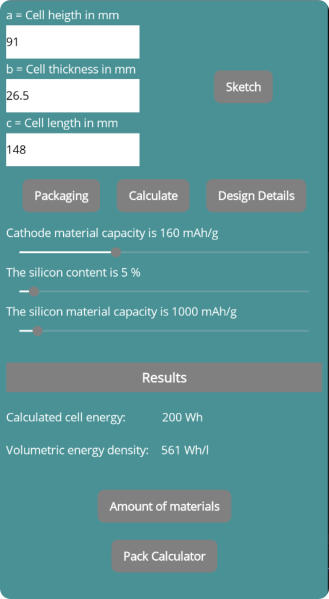

1

2

3

3

4
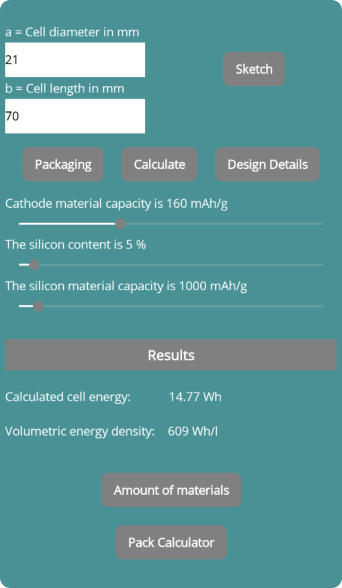

1

2

3

3

4
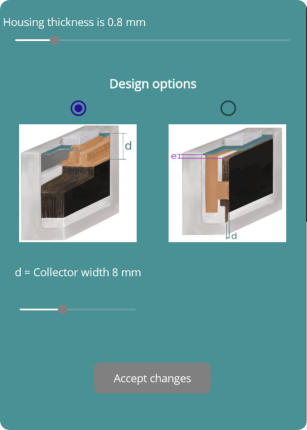
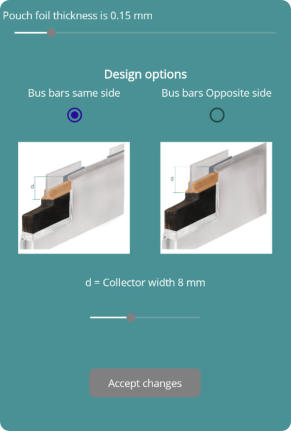
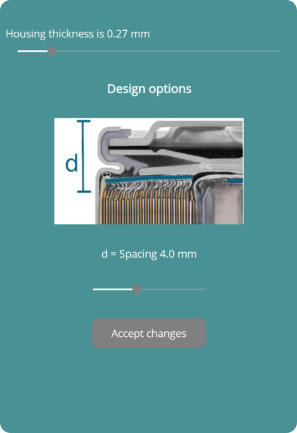
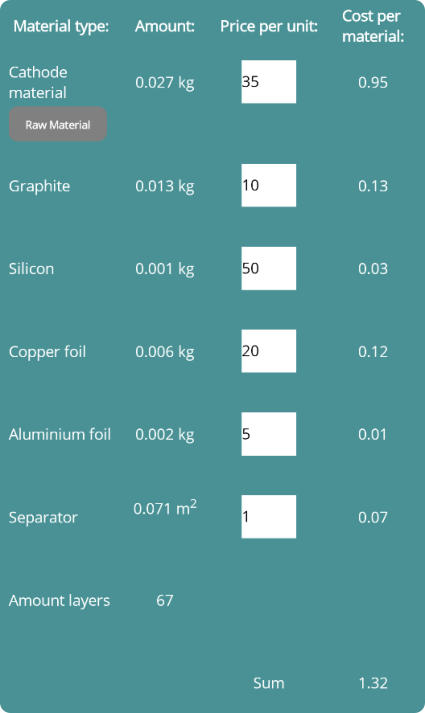

1
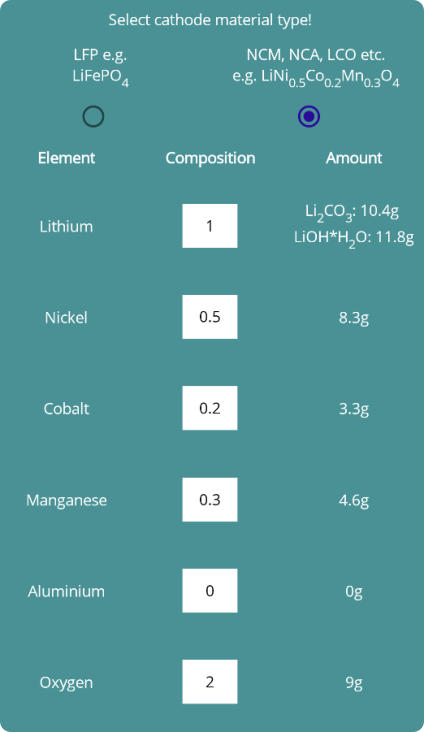

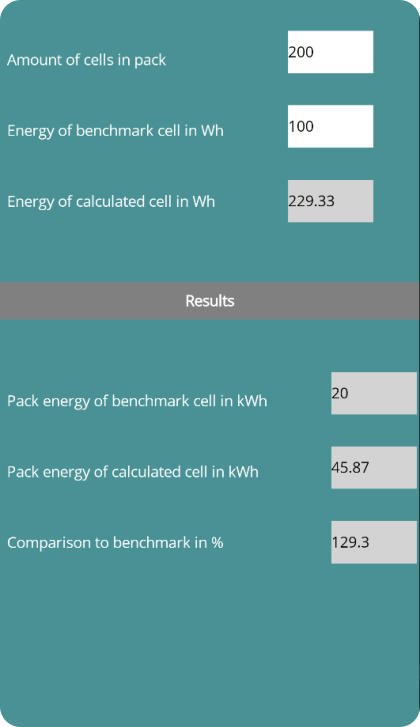
Other starting options:
Import Settings:
You
have
the
option
of
having
present
parameters
sent
to
you
and
importing
them
to
start
your
calculation
with
defined
conditions.
To
do
this,
you
have
to
select
the
desired
.lic
file
via
„import
settings“
first.
Then
you
can
start
your
calculation
by selecting the cell type.
Reset
:
If you want to start again with the parameters we set arbitrarily, first click on „Reset“.
Saving options:
Save:
After
you
did
the
cell
calculation,
you
can
save
all
parameters
so
that
you
can
start
again
with
the
same
parameters
for
your next cell calculation. For example, you can always start with the same geometric data without having to re-enter them.
If
you
exit
the
app
without
saving
first,
you
will
start
the
next
cell
calculation
again
with
the
last
saved
parameters
or
the
parameters we set arbitrarily if you habe nerver saved before.
Save and share:
You
have
the
possibility
of
saving
your
set
parameters
and
sending
them
to
someone
by
creating
a
.lic
file
by
clicking
on
„Save
and
share“.
You
can
then
send
this
to
another
user
e.g.
by
e-mail
so
that
he
can
start
his
calculation
with
your
para
-
meters.
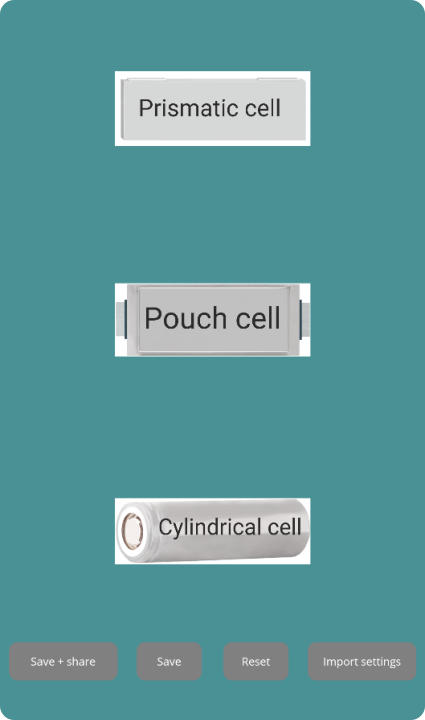

1

2

3

4

4

3

2

1
If
you
have
set
all
parameters
in
the
previous
levels,
you
can
calculate
the
total
energy
of
a
battery
pack.
Additionally
you
can
see
the
energy
of
your calculated cell compared to a known cell at pack level.
To
do
this,
simply
enter
the
number
of
cells
and
the
energy
of
the
known
cell.
You
will
then
see
the
packing
energy
of
your
and
the
known
cell
in
the
results as well as the direct comparison in %.
In
this
example,
a
pack
with
your
calculated
cell
has
129.3%
more
energy than a pack with the known cell.
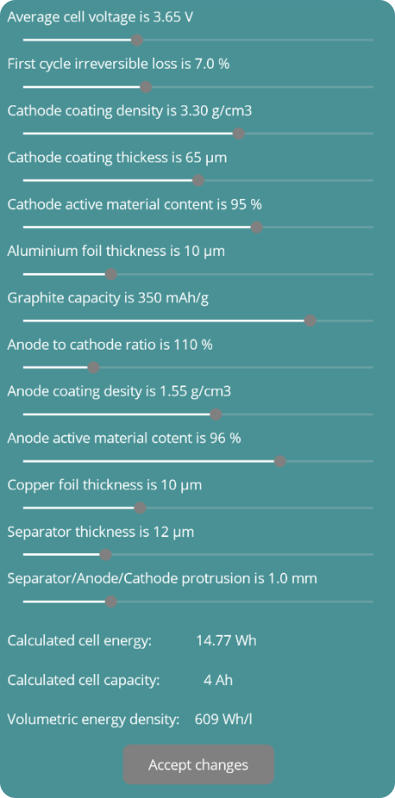
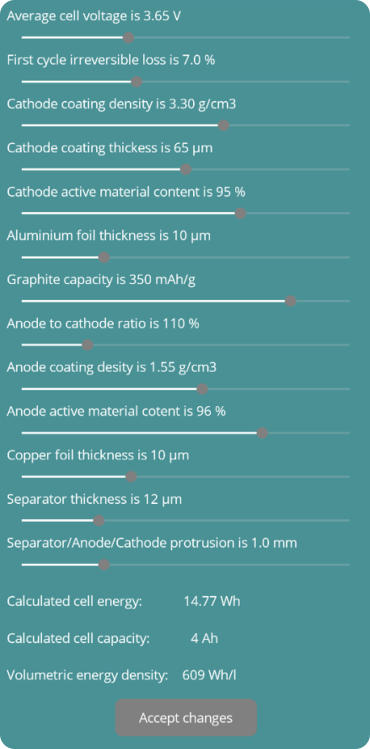
Description of levels


The
development
and
calculation
of
your
lithium-ion
cell
beg
-
ins
with
the
selection
of
the
cell
type.
You
can
choose
between
3
different
cell
types.
By
clicking
on
the
respective
button
of
the
desired
cell
type
you
get
to
the
main
level
of
the
app.
The
prismatic
cell
has
a
solid
metal
case with both contacts in the lid.
To
simplify
the
calculation
of
the
cell
parameters,
it
is
assumed
that
the
electrodes
and
the
separator
are
stacked.
Wound
electrodes
are
not
considered.
The
cylindrical
cell
has
a
solid
metal
case.
The
electrodes
are
wound
up
together
with
the
separator
to
a
so-cal
-
led
jelly
roll
and
inserted
into
the
hou
-
sing.
The
bottom
and
top
of
the
cylindrical cell represent the contacts.
Prismatic and Pouch cell
Cylindrical cell









Level 1:
Selection of the cell type

Level
2
represents
the
main
level
of
the
app.
Here
you
can
calculate
the
energy
of
your
cell
with
just
a
few
settings.
First
you
have
to
specify
the
geometry
of
your
cell.
You
need
height,
width
and
length
for
the
prismatic
and
the
pouch
cell
or height and radius for the cylindrical cell.
A
drawing
(click
on
the
button
Sketch
)
reveals
with
value
is
meant
You
can
already
have
the
energy
of
your
cell
calcula
-
ted
by
clicking
the
"Calculate"
button
.
In
order
to
enable
such
a
calcu
-
lation,
arbitrary
values
for
varial
-
bel
parameters
have
been
defined.
Now
you
can
change
3
parame
-
ters
on
this
level
using
sliders
and
observe
what
influence
these
parameters
have
on
cell
energy.
If
you
would
like
to
describe
your
cell
more
precisely
and
define
your
own
parameters,
switch
to
level
3
by
clicking
on
the detail buttons
.
You
will
then
return
to
this
level.
After
you
have
adjusted
all
values,
the
energy
of
the
cell
will
be calculated as a result.
In
addition,
the
required
amount
of
material
for
this
cell
is
calcu
-
lated,
you
will
find
these
results
when
you
switch
to
the
next
level
.

1

2

3

4
The
wall
thickness
of
the
housing
for
the
prismatic
cell
can
now
be
specified here.
Since
the
foils
can
be
connected
to
the
tabs
in
different
ways,
it
is
pos
-
sible
to
define
how
the
connection
should
be
and
how
big
the
distan
-
ces
are.
Here
you
can
find
illustrati
-
ons which show what is meant.
The
film
thickness
of
the
pouch
foil
can now be specified.
The
connection
to
the
tabs
and
the
feed-through
can
be
opposite
or
on
the
same
side,
which
can
be
speci
-
fied
here.
In
addition,
the
distances
from
the
coating
to
the
outer
edge
of the pouch can be specified.
The
thickness
of
the
housing
can
also
be
specified
for
the
cylindrical
cell.
Furthermore,
the
distance
between
the
jellyroll
and
the
lid
can
be
spe
-
cified,
which
influences
the
dead
volume.
In
the
design
details
you
have
the
possibility
to
set
the
para
-
meters
that
you
know
from
your
cell
and/or
to
vary
parame
-
ters
and
observe
their
influence
on
the
cell
energy.
Moving
the
slider
changes
the
cell
energy
directly
(at
the
bottom
of
this
page).
It
is
not
checked
for
plausibility,
so
it
is
possible
that
your
information
cannot
be
implemented
in
practice
or
that
the
combination
of
some
parameter
values
does
not
make sense. So you should know what you are doing.
When
you
have
set
the
parameters,
you
go
back
to
level
2
and
there
you
can
switch
to
level
4
where
you
can
find
the
result
area,
the
output
of
the
material
quantity
and
the
cost
calculation.
When
you
have
set
all
the
para
-
meters,
you
can
see
how
much
material
you
need
for
your
cell.
In
addition,
the
number
of
elec
-
trode
layers
is
calculated
based
on
your
cell
thickness
and
stack
details.
If
you
want
to
know
the
material
costs
for
your
cell
or
the
individual
materials,
you
can
enter
prices
per
unit
and
the
app
will
calculate
the
individual
costs
and
the
sum
of
the
cell
material costs.
This
level
is
only
used
to
calcu
-
late
raw
material
quantities,
the
definition
of
the
cathode
mate
-
rial
on
this
level
has
no
effect
on the other levels.
You
first
heve
to
choose
whe
-
ther
you
want
to
calculate
an
LFP
or
other
metal
oxide
cathode,
such
as
NCM523.
After
specifying
the
stoichio
-
metric
element
ratios,
you
can
calculate
the
amount
of
raw
materials required.
The
pouch
cell
does
not
have
a
fixed
housing,
the
electrode
stack
is
sealed
in
special
foil.
There
are
2
different
ways
of
leading
the
tabs
out
of
the
foil.
You
can
choose
between
opposite
or
equilateral arrangement.
No
other
costs
(housing,
electrolyte,
production
costs,
etc.)
are
taken
into
account
here,
only
the
materials
mentioned
are
included in the total.
For
a
detailed
calculation
of
the
raw
material
quantities,
you
have
to
describe
the
cathode
material
in
more
detail.
You
can
do this on the next level (click the button
).

1
There
is
no
plausibility
check
here
either,
i.e.
you
can
define
LFP
as
the
cathode
material,
for
example,
but
specify
a
hig
-
her capacity on level 2 than it is theoretically possible for LFP.
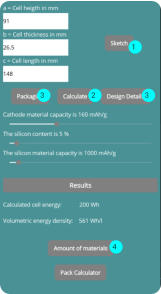
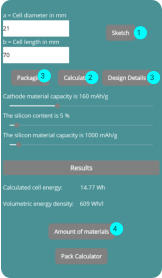
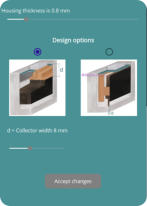
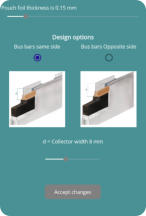
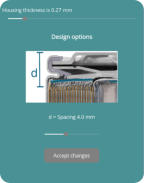















1
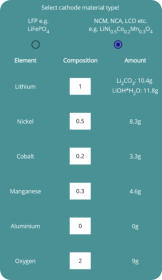


Other starting options:
Import Settings:
You
have
the
option
of
having
present
parameters
sent
to
you and importing them to start your calculation with defined
conditions.
To
do
this,
you
have
to
select
the
desired
.lic
file
via „import settings“ first. Then you can start your calculation
by selecting the cell type.
Reset
:
If
you
want
to
start
again
with
the
parameters
we
set
arbitra
-
rily, first click on „Reset“.
Saving options:
Save:
After
you
did
the
cell
calculation,
you
can
save
all
parameters
so that you can start again with the same parameters for
your
next
cell
calculation.
For
example,
you
can
always
start
with
the
same
geometric
data
without
having
to
re-enter
them.
If
you
exit
the
app
without
saving
first,
you
will
start
the
next
cell calculation again with the last saved parameters or the
parameters we set arbitrarily if you habe nerver saved before.
Save and share:
You
have
the
possibility
of
saving
your
set
parameters
and
sending them to someone by creating a .lic file by clicking on
„Save
and
share“.
You
can
then
send
this
to
another
user
e.g.
by e-mail so that he can start his calculation with your para
meters.

1

2

4

3

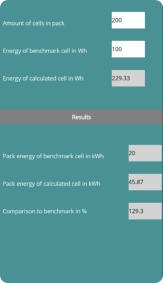
If
you
have
set
all
parameters
in
the
previous
levels,
you
can
calculate
the
total
energy
of
a
battery
pack.
Additionally
you
can
see
the
energy
of
your
calculated
cell
compared
to
a
known cell at pack level.
To
do
this,
simply
enter
the
number
of
cells
and
the
energy
of the known cell.
You
will
then
see
the
packing
energy
of
your
and
the
known
cell
in
the
results
as
well
as
the
direct comparison in %.
In
this
example,
a
pack
with
your
calculated
cell
has
129.3%
more
energy
than
a
pack
with
the known cell.









